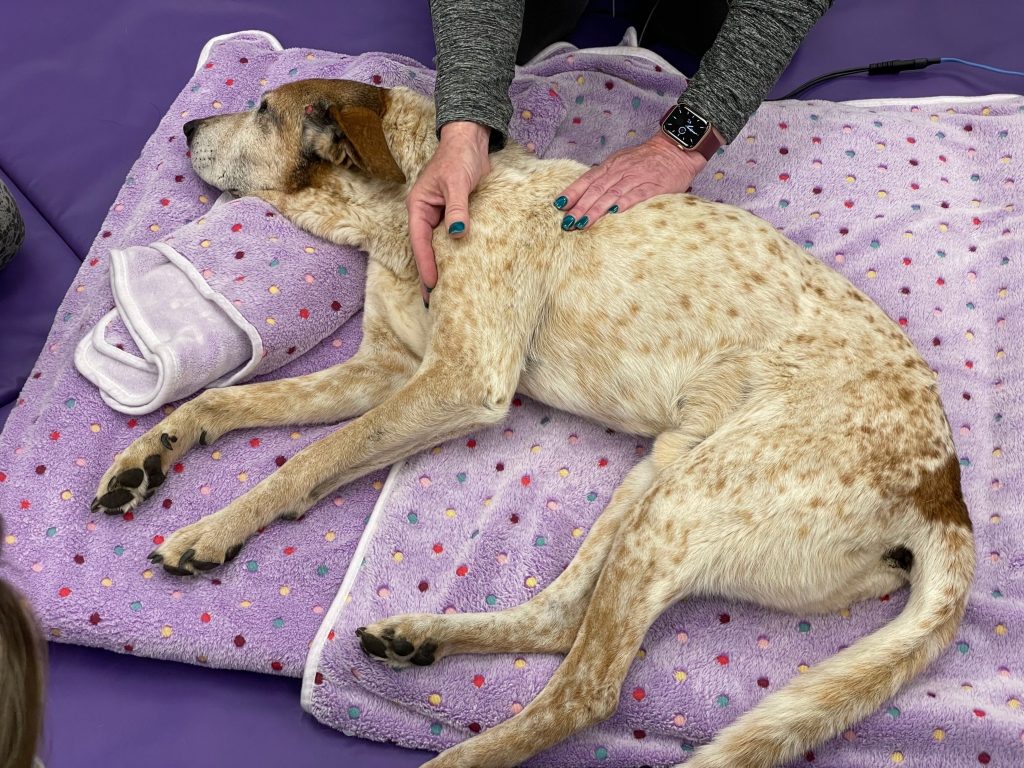Suppose you live in a state where it is legal to discuss cannabinoid medical options with clients. Especially for chronic inflammatory conditions, could hemp-derived cannabidiol (CBD) provide a suitable choice, whether alone or in conjunction with medications? Compared to most other phytotherapeutics, CBD has amassed stronger evidential support and more transparent quality control. Certainly, more remains to be known about dosing and drug-herb interactions.
Nevertheless, evidence indicates CBD is safer and demonstrates a more diverse spectrum of beneficial mechanisms than its pharmaceutical counterparts. In short, dogs and cats do not die from CBD. They do not develop gastrointestinal ulceration or perforation when taking CBD; or liver failure, or kidney disease, or any of the other worrisome side effects that can happen with non-steroidal anti-inflammatory drugs (NSAID) and corticosteroids.1
Further, in contrast, anti-nerve growth factor monoclonal antibodies (anti-NGF mABs), CBD, and other cannabis constituents will not suppress endogenous growth factors the nervous system requires for maintenance and repair. Giving CBD does not require monthly, sometimes painful injections; it comes in biscuits, oils, capsules, and creams.
Patients do not run the risk of developing any of the issues noted for anti-NGF mABs, such as urinary tract infections, altered sensations, interference with bone remodeling, kidney function changes, skin infection, or damage to joint integrity.2,3 In fact, CBD has exhibited tissue protective and anti-inflammatory effects in models of neurodegeneration, neural injury, kidney and liver disease, cardiovascular disease, arthritis, sepsis, diabetes, diabetic complications, cancer, epilepsy, and more.4
While CBD may cause diarrhea, excessive sedation, or elevations in alkaline phosphatase, for many clients seeking other options, the positives often outweigh concerns.

CBD and inflammation
So, CBD sounds promising, but how does it actually attenuate inflammation?
CBD is not an NSAID, so it does not block cyclooxygenase. In contrast to anti-NGF mABs, CBD is neuroprotective and neurorestorative, not neurodestructive, but may still significantly reverse NGF-induced mechanical sensitization.5 The best terms that describe many of the anti-inflammatory and analgesic effects of CBD are “neuromodulatory” and “immunomodulatory.” In other words, CBD modulates (i.e. balances activity in the nervous and immune systems, including the endocannabinoid system [ECS]).6 The detailed mechanisms sound closer to what the body does naturally to resolve inflammation than how NSAIDs or mABs work.
The emphasis on “fighting” inflammation obscures the fact inflammation serves a protective benefit in response to injury and pathogens. The influx of white blood cells (WBCs) that surrounds traumatized tissue wall off the area to prevent migration of organisms into other regions. Pain and swelling reduce movement and limit further damage. Soon after acute inflammatory processes begin, however, endogenous mechanisms start to mobilize a complex sequence of inflammation-resolving activities. If these resolution programs are insufficient or interfered with, inflammation may become chronic, uncontrolled, and unresolved. Difficult-to-treat inflammatory states, such as arthritis and atopy may take hold.7
The resolution phase that occurs requires the biosynthesis of active mediators that foster return to homeostasis, (i.e. the pre-injury state. Pro-resolving mediators act on specific receptor targets to halt WBC recruitment, promote WBC apoptosis, clear apoptotic cells via macrophages, and reprogram macrophage phenotypes from pro-inflammatory to
pro-resolving).7
CBD interfaces with these processes in several ways, with only a few examples presented here. Notably, CBD is an agonist of a receptor known as the proliferator-activated receptor gamma (PPARG), which interacts directly with the transcription factor nuclear factor kappa B (NFKB). NFKB regulates many innate and adaptive immune activities and works as a pivotal mediator of inflammation.8 NFKB also oversees the survival, activation, and differentiation of immune cells and inflammatory T cells.
PPARG modulates inflammation by inhibiting NFKB-mediated inflammatory signaling. It also reduces the expression of pro-inflammatory genes, leading to a reduction in cyclooxygenase and several pro-inflammatory mediators. These include tumor necrosis factor-alpha, interleukin 1-beta, and interleukin 6. Thus, a PPARG agonist such as CBD fights inflammation, at least in part, by inhibiting the NFKB-mediated transcription of pro-inflammatory genes.
Another mechanism by which CBD limits the generation of pro-inflammatory mediators relates to its modulation of transient receptor potential vanilloid 1 (TRPV1) channel activity. CBD inhibits activation of the Janus kinase/signal transducer as well as the transcription signaling pathway; this further reduces production of pro-inflammatory cytokines.9 CBD protects against cellular damage from an overactive immune system by modulating adenosine signaling. These dual anti-inflammatory and immunomodulatory actions highlight the possible value of CBD for conditions such as multiple sclerosis, type I diabetes, and rheumatoid arthritis.
CBD also works through the ECS, but less direct manner compared to THC (delta-9 tetrahydrocannabinol), which is a partial agonist to its receptors. For those unfamiliar with the ECS, this extensive neural network responds in a neuromodulatory manner to trauma and stress. It supports central nervous system development, synaptic plasticity, and immune regulation. It comprises cannabinoid receptors (e.g. CB1 and CB2), endogenously produced cannabinoid ligands (anandamide, or AEA, and 2-arachidonoyl glycerol, or 2-AG), and enzymes that synthesize and degrade the endocannabinoids (ECs).
Although CBD demonstrates a weak affinity to both types of CB receptors (CB1 and CB2), it does possess the capacity to raise EC levels which, in turn, activate PPAR-alpha (by AEA) and increase PPAR-alpha transcriptional activity (by 2-AG).10 PPAR-alpha agonism regulates and protects against oxidative stress. This results in both anti-inflammatory and anti-oxidative actions.
CBD also acts on serotonin and opioid receptors throughout brain areas associated with anxiety and pain, showing how its mechanisms of action supersede just control of inflammation.11
Can CBD treat atopy?
Atopic dermatitis constitutes an emerging area of interest for clinical application of CBD. Since CB2 receptors exist in both healthy and diseased canine skin,12 as do cannabinoid-related receptors (GPR55, TRPV1, and TRPA1). Based on these findings, the ECS presents an attractive therapeutic target for cannabinoid medicine to treat dermatitis of many types. It also invites us to consider the role of topical CBD for more direct absorption.
An in vitro report comparing CBD to dexamethasone (DEX) indicated that CBD and DEX exhibited similar anti-inflammatory effects on lipopolysaccharide (LPS)-stimulated RAW264.7 macrophages.13 Both inhibited LPS-induced production nitric oxide, interleukin-6 (IL-6), and tumor necrosis factor alpha (TNF-alpha). CBD, but not DEX, attenuated JNK phosphorylation levels, and only DEX attenuated IKK phosphorylation.
A prospective, randomized, double-blind, placebo-controlled trial of 32 dogs with atopic dermatitis showed administering CBD, in conjunction with CBDA, its precursor molecule, also reduced pruritus, but not associated skin lesions.14 Other research indicated oral administration of CBD reduced pruritic behavior in atopic dogs without significant
adverse effects.15
With respect to drug-herb interactions, if CBD does inhibit the metabolizing enzyme CYP3A4 as preclinical work suggests, this may delay elimination of co-administered compounds that share cytochrome substrates, such as prednisolone. The good news here is, perhaps for those dogs that require systemic prednisolone for atopy control, concomitant inclusion of CBD might present an opportunity to reduce the dose of prednisolone.
CBD for osteoarthritis
For dogs with osteoarthritis, a systematic review of randomized clinical trials,16 found several studies indicating that CBD significantly reduces pain and increases locomotor activity. In some studies, dogs who participate these types of studies continue to receive anti-inflammatory medication which has not caused problems.
In fact, CBD may confer additional benefits when in conjunction with NSAIDS. Of course, more studies are needed to fully examine the risks and benefits of combining CBD with pharmaceuticals.17

Who benefits by making CBD discussions illegal?
In a sobering post, Stacey Oke, DVM, MSc, quoted Charlotte Lacroix, DVM, JD, “Six states’ licensing bodies acknowledge that a veterinarian could lose their license if they even discuss CBD, two states said you can have a conversation with your clients but only if they initiate the conversation, and in 18 states you may discuss CBD products, but you cannot prescribe or dispense them.” Dr. LaCroix concluded, “In sum, while CBD may ultimately prove to be a wonderful treatment modality, it cannot currently be recommended, sold, or stocked by veterinarians.”18 Who is this helping? Who is this harming? Who serves to benefit financially by restricting veterinarians’ conversations
about CBD, and where is the scientific justification?
Narda Robinson, DO, DVM, MS, FAAMA, practices osteopathic medicine and veterinary medicine. Dr. Robinson taught science-based integrative medicine at the Colorado State University College of Veterinary Medicine and Biomedical Sciences for 20 years. In 2016, Robinson established her own academy in Fort Collins, Colo., where she teaches medical acupuncture, integrative rehabilitation, medical massage, and other integrative medical approaches.
References
1. Food and Drug Administration. Veterinary Nonsteroidal Anti-Inflammatory Drugs (NSAIDs). Accessed on August 2, 2023 at https://www.fda.gov/animal-veterinary/product-safety-information/veterinary-nonsteroidal-anti-inflammatory-drugs-nsaids.
2. Miller RE, Block JA, and Malfait AM. Nerve growth factor (NGF) blockade for the management of osteoarthritis pain: what can we learn from clinical trials and preclinical models? Curr Opin Rheumatol. 2017;29(1):110-118.
3. Zhao D, Zeng L-F, Liang G-H, et al. Does anti-nerve growth factor monoclonal antibody treatment have the potential to replace nonsteroidal anti-inflammatory drugs and opioids in treating hip or knee osteoarthritis? A systematic review of randomized controlled trials. Efort Open Reviews. General Orthopaedics. 2022;7:7; 470-480. Accessed at https://eor.bioscientifica.com/view/journals/eor/7/7/EOR-21-0103.xml?body=pdf-59161 on August 2, 2023.
4. Pacher P, Kogan NM, and Mechoulam R. Beyond THC and endocannabinoids. Annu Rev Pharmacol Toxicol. 2020;60:637-659.
5. Wong H and Cairns BE. Cannabidiol, cannabinol and their combinations act as peripheral analgesics in a rat model of myofascial pain. Archives of Oral Biology. 2019;104:33-39.
6. Yu CHJ and Rupasinghe HPV. Cannabidiol-based natural health products for companion animals: Recent advances in the management of anxiety, pain, and inflammation. Research in Veterinary Science. 2021;140;38-46.
7. Sugimoto MA, Sousa LP, Pinho V, et al. Resolution of inflammation: what controls its onset? Frontiers in Immunology. 2016; 7:160.
8. Liu T, Zhang L, Joo D, et al. NF-kB signaling in inflammation. Signal Transduction and Targeted Therapy. 2017: 2, Article number: 17023.
9. Peyravian N, Deo S, Daunert S, et al. Cannabidiol as a novel therapeutic for immune modulation. Immunotargets Ther. 2020;9:131-140.
10. Almogi-Hazan O and Or R. Cannabis, the endocannabinoid system, and immunity–the journey from the bedside to the bench and back. Int J Mol Sci. 2020;21(12):4448.
11. De Almeida DL and Devi LA. Diversity of molecular targets and signaling pathways for CBD. Pharmacology Research & Perspectives. 2020;8(6):e00682. https://doi.org/10.1002/prp2.682
12. Chiocchetti R, Salamanca G, De Silva M, et al. Cannabinoid receptors in the inflammatory cells of canine atopic dermatitis. Front Vet Sci. 2022;9:987132.
13. Wang Y, Want X, Yang Y, et al. Comparison of the in vitro anti-inflammatory effect of cannabidiol to dexamethasone. Clin Cosmet Investig Dermatol. 2022;15:1959-1967.
14. Loewinger M, Wakshlag JJ, Bowden D, et al. The effect of a mixed cannabidiol and cannabidiolic acid based oil on client-owned dogs with atopic dermatitis. Veterinary Dermatology. 2022;33:329-e77.
15. Mogi C, Yoshida M, Kawano K, et al. Effects of cannabidiol without delta-9-tetrahydrocannabinol on canine atopic dermatitis: A retrospective assessment of 8 cases. Can Vet J. 2022;63(4):423-426.
16. De Mendonca Lima T, Santiago NR, Alves ECR, et al. Use of cannabis in the treatment of animals: a systematic review of randomized clinical trials. Anim Health Res Rev. 2022;23(1):25-38.
17. Alvarenga IC, Pannickar KS, Hess H, et al. Scientific validation of cannabidiol for management of dog and cat diseases. Annu Rev Anim Biosci. 2023; 11:227-246.
18. Oke S. Navigating the haze of CBD legalities in equine practice. The Horse. January 12, 2021. Accessed at https://thehorse.com/196453/navigating-the-haze-of-cbd-legalities-in-equine-practice/ on August 3, 2023.
